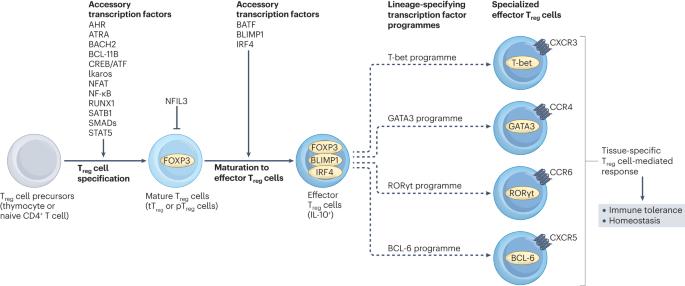转录因子在塑造调节性T细胞身份中的作用。
IF 67.7
1区 医学
Q1 IMMUNOLOGY
引用次数: 0
摘要
叉头盒蛋白3表达(FOXP3+)调节性T细胞(Treg细胞)抑制常规T细胞,对免疫耐受至关重要。FOXP3是Treg细胞的主转录因子,控制多个基因的表达,指导Treg细胞的分化和功能。然而,只有一小部分regg细胞相关基因直接与FOXP3结合,并且FOXP3本身不足以完全指定Treg细胞程序,这表明其他辅助转录因子在FOXP3的上游、下游和/或同时工作,指导Treg细胞的特化和特化功能。事实上,Treg细胞的异质性可以至少部分归因于转录因子的差异表达,这些转录因子微调了它们的运输、存活和功能特性,其中一些是利基特异性的。在这篇综述中,我们讨论了辅助转录因子在控制Treg细胞身份中的新作用。我们特别关注基本螺旋-环-螺旋家族(AHR),基本亮氨酸拉链家族(BACH2, NFIL3和BATF), CUT同源盒家族(SATB1),锌指结构域家族(BLIMP1, Ikaros和BCL-11B)和干扰素调节因子家族(IRF4)的成员,以及谱系定义转录因子(T-bet, GATA3, RORγt和BCL-6)。了解Treg细胞身份和特化功能的印记将是揭示自身免疫基本机制和确定药物开发新靶点的关键。本文章由计算机程序翻译,如有差异,请以英文原文为准。

The role of transcription factors in shaping regulatory T cell identity
Forkhead box protein 3-expressing (FOXP3+) regulatory T cells (Treg cells) suppress conventional T cells and are essential for immunological tolerance. FOXP3, the master transcription factor of Treg cells, controls the expression of multiples genes to guide Treg cell differentiation and function. However, only a small fraction (<10%) of Treg cell-associated genes are directly bound by FOXP3, and FOXP3 alone is insufficient to fully specify the Treg cell programme, indicating a role for other accessory transcription factors operating upstream, downstream and/or concurrently with FOXP3 to direct Treg cell specification and specialized functions. Indeed, the heterogeneity of Treg cells can be at least partially attributed to differential expression of transcription factors that fine-tune their trafficking, survival and functional properties, some of which are niche-specific. In this Review, we discuss the emerging roles of accessory transcription factors in controlling Treg cell identity. We specifically focus on members of the basic helix–loop–helix family (AHR), basic leucine zipper family (BACH2, NFIL3 and BATF), CUT homeobox family (SATB1), zinc-finger domain family (BLIMP1, Ikaros and BCL-11B) and interferon regulatory factor family (IRF4), as well as lineage-defining transcription factors (T-bet, GATA3, RORγt and BCL-6). Understanding the imprinting of Treg cell identity and specialized function will be key to unravelling basic mechanisms of autoimmunity and identifying novel targets for drug development. Regulatory T cells (Treg cells) are controlled by a raft of transcription factors besides Forkhead box protein 3 (FOXP3). As detailed in this Review, these accessory transcription factors act alone or together with FOXP3 to coordinate Treg cell specification and function, and account for heterogeneity of niche-specific Treg cells.
求助全文
通过发布文献求助,成功后即可免费获取论文全文。
去求助
来源期刊

Nature Reviews Immunology
医学-免疫学
CiteScore
93.40
自引率
0.40%
发文量
131
审稿时长
6-12 weeks
期刊介绍:
Nature Reviews Immunology is a journal that provides comprehensive coverage of all areas of immunology, including fundamental mechanisms and applied aspects. It has two international standard serial numbers (ISSN): 1474-1733 for print and 1474-1741 for online. In addition to review articles, the journal also features recent developments and new primary papers in the field, as well as reflections on influential people, papers, and events in the development of immunology. The subjects covered by Nature Reviews Immunology include allergy and asthma, autoimmunity, antigen processing and presentation, apoptosis and cell death, chemokines and chemokine receptors, cytokines and cytokine receptors, development and function of cells of the immune system, haematopoiesis, infection and immunity, immunotherapy, innate immunity, mucosal immunology and the microbiota, regulation of the immune response, signalling in the immune system, transplantation, tumour immunology and immunotherapy, and vaccine development.
 求助内容:
求助内容: 应助结果提醒方式:
应助结果提醒方式:


